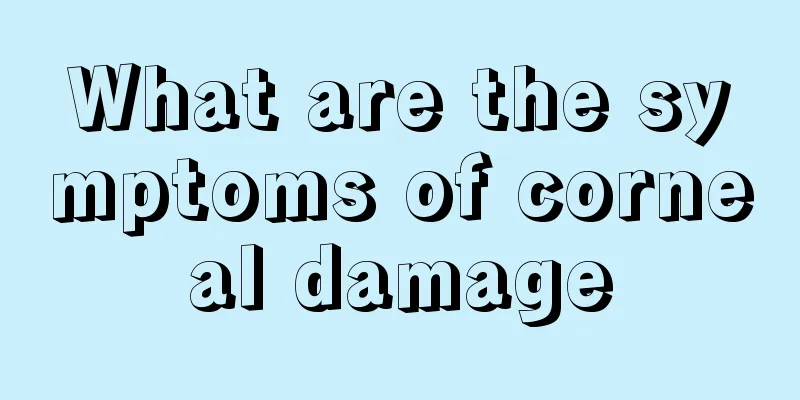What are the symptoms of corneal damage

|
I believe that many people often encounter the problem of corneal injury in their daily lives. Most of the corneal injuries are caused by accidental bumps or bruises. They are often accompanied by corneal pain, red and swollen eyes, prolonged tears, fear of light and wind, so you must slowly adjust your condition to prevent the condition from getting worse. Clinical manifestations 1) Corneal abrasion: The patient's vision in the injured eye is impaired because the sensory nerve endings of the injured eye's cornea are exposed. Immediately after the injury, the patient experiences severe pain, photophobia, foreign body sensation, eyelid spasm, and heavy tearing. Tears also flow in the contralateral healthy eye. The severity of symptoms is related to the extent of the injury. Examination under the slit lamp can reveal oblique, dull, band-like lesions of the corneal epithelium or clearly demarcated, flake-like areas without epithelial defects, with a flat and smooth anterior Descemet's membrane underneath. The pupil is reflexively constricted and the corneal margin is ciliary congested. To further examine the extent of epithelial edema and defects, one drop of 1% to 2% sodium fluorescein solution can be instilled into the conjunctival sac. Under cobalt blue light, the area of corneal epithelial edema or defects will appear bright green. The most common complication of corneal abrasion is infection. Because the corneal epithelium is an important protective barrier of the eye, corneal abrasion can cause local infiltration of the corneal stroma, and infection by pathogens carried by the wounding object can aggravate the symptoms. 2) Loss of deep corneal tissue: Symptoms of corneal abrasion such as pain, photophobia, foreign body sensation and tearing exist but are relatively mild. Examination under the slit lamp reveals edema, thickening and opacity of the corneal stroma, and wrinkles in the posterior Descemet's membrane, which may be localized. Corneal lamellar lacerations may sometimes occur, which may be accompanied by infection and ulcers. 3) Corneal contusion: The main symptoms are pain, photophobia, tearing, ciliary congestion and decreased vision. Mild corneal contusion causes local damage to corneal tissue, and linear, lattice-shaped, and disc-shaped opacities can be seen on the cornea; more severe contusion can cause damage to the corneal endothelial cells, weakening or even losing the water pumping function within the matrix, leading to increased corneal water content and lumpy or diffuse edema of the corneal matrix. 4) Interlaminar corneal laceration: Patients often experience pain, photophobia, tearing and decreased vision. Due to the edema or lift of the torn corneal flap, patients will have an obvious foreign body sensation. Under the slit lamp, the torn corneal flap can be seen flipped up and curled up, and the corneal flap and surrounding stroma are edematous. 5) Corneal perforation and rupture: Corneal rupture caused by strong external force often occurs near the corneal edge because the structure here is relatively weak. The patient has a clear history of eye trauma, and may experience transient pain during the injury and persistent pain after the injury. Due to full-thickness corneal laceration, aqueous humor flows out and the patient will feel a stream of hot water flowing out of the injured eye. The injured eye will experience symptoms such as photophobia, tearing, blepharospasm and decreased vision due to corneal damage. Most corneal wounds are located in the palpebral fissure, and the Seidel test can be used to determine whether the wound is closed. Larger lacerations or irregular wounds may cause the anterior chamber to become shallower due to the outflow of aqueous humor, and the pupil to become pear-shaped or displaced. The iris may often be seen incarcerated in the corneal wound. The iris corresponding to the corneal wound may have iris perforation, and severe contusion may also cause iris root detachment accompanied by anterior chamber hemorrhage. Deep corneal perforations can cause lens damage, which may cause rupture of the anterior lens capsule, opacity of the lens cortex or overflow into the anterior chamber, or rupture of the posterior lens capsule. Severe damage can cause the lens to subluxate or even completely dislocate into the vitreous cavity. Due to the high force of trauma, the lens is dislocated, and the vitreous body is often embedded in the anterior chamber, or even prolapsed together with the retina. Careful examination and identification should be carried out under the slit lamp. |
<<: What to do if cornea is burned
>>: How to treat liver and gallbladder obstruction
Recommend
What is the best way to drink chrysanthemum in water
Chrysanthemum is a common Chinese medicine in our...
Can floral water cure body odor?
Summer weather is hot, and the human body is usua...
Running sandbag leggings
Many people tie their legs with sandbags when run...
Can aloe vera capsules cure constipation?
Everyone has a different physical constitution. S...
Introduction to head massage techniques
We all know that if the body is particularly tire...
Precautions for oxygen delivery
If a person is suddenly exposed to a plateau envi...
What are some simple ways to make bread at home?
I believe that bread is a must-have food for brea...
How much do you know about the dangers of ovarian teratoma
This problem is of great concern to many female f...
Do I need chemotherapy after cancer surgery?
Chemotherapy is not always needed after cancer su...
Basis for early diagnosis of osteosarcoma
When people suspect that they have osteosarcoma, ...
Can depression be completely cured? Here are 5 treatment methods
With the development of society, people's tho...
The left side of my head sweats but the right side doesn't
The left side of my head sweats but the right sid...
Why is my right eye twitching? Beware of these reasons
Many people think that the right eye twitching is...
What are the early symptoms of cholecystitis
Cholecystitis is divided into acute cholecystitis...
Can I use saline solution to apply to my face if I have allergies?
The skin on the face is a high-risk area for alle...









